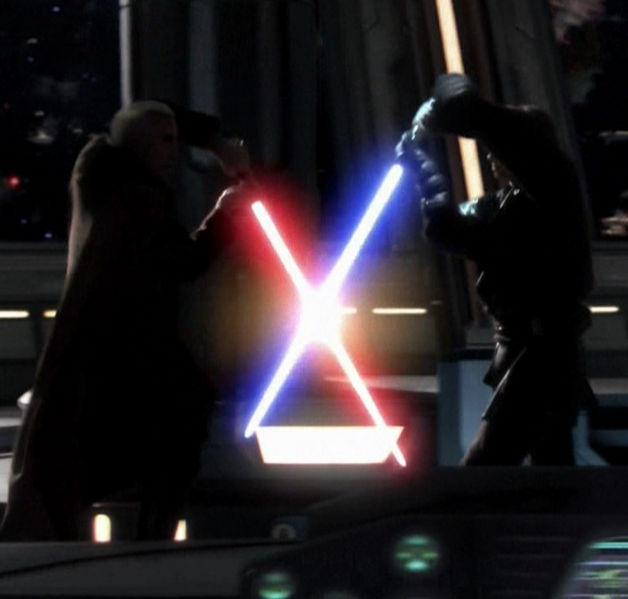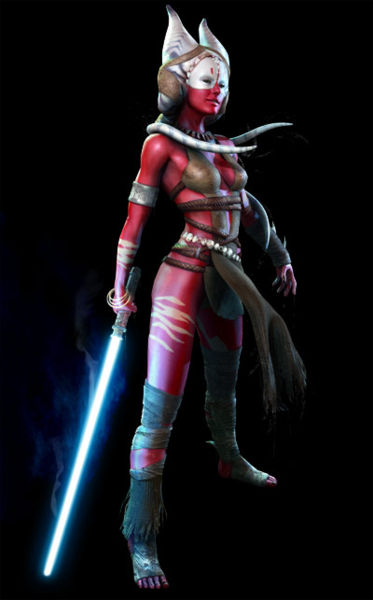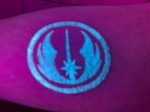Log in
History of the Jedi, lesson 2
Wed Sep 09, 2009 12:10 pm by Scotland
History of Jedi Order, Lesson 2
Early history(continued.)
From the ashes of these wars arose the early Jedi, and their Jedi Forge initiation ceremony, which led to the eventual invention of lightsabers after they faced threats from beyond Tython.
Through the use of advanced off-world technology, the Jedi were able to "freeze" a laser beam, resulting in the birth of the …
From the ashes of these wars arose the early Jedi, and their Jedi Forge initiation ceremony, which led to the eventual invention of lightsabers after they faced threats from beyond Tython.
Through the use of advanced off-world technology, the Jedi were able to "freeze" a laser beam, resulting in the birth of the …
Comments: 0
The Force...
Thu Sep 24, 2009 1:16 am by Saiana
The Force was a metaphysical, binding, and ubiquitous power that held enormous importance for both the Jedi and Sith monastic orders. The Force was viewed in many different aspects, including, but not limited to, the light side, the dark side, the Unifying Force, and the Living Force. The first two aspects were concerned with the moral compass of the Force in its various manifestations. The light …
Comments: 9
The Lightsaber
Fri Sep 25, 2009 1:48 pm by Saiana
"This was the formal weapon of a Jedi Knight. Not as clumsy or random as a blaster. More skill than simple sight was required for its use. An elegant weapon. It was a symbol as well. Anyone can use a blaster or a fusioncutter—but to use a lightsaber well was a mark of someone a cut above the ordinary."
―Obi-Wan Kenobi
Designed as much for elegance in combat as for ceremony, the …
Comments: 6
Search
Form II: Makashi
Page 1 of 1
 Form II: Makashi
Form II: Makashi
"He is a fencer. Leverage, position, advantage—they are as natural to him as breathing."
- Qui-Gon Jinn's spirit to Yoda
Form II: Makashi, also known as The Way of the Ysalamiri, or The Contention Form, was the second form of the seven forms of lightsaber combat.
After Form I's proliferation as a lightsaber combat technique, Form II came about as a means of lightsaber-to-lightsaber combat. It was described as being very elegant, powerful, and requiring extreme precision, allowing the user to attack and defend with minimal effort, while his opponent tires himself out, often wielding the blade one-handed for greater range of movement and fluidity. The form relied on parries, thrusts, and small, precise cuts—as opposed to the blocking and slashing of the other forms. Form II countered sun djem, the goal of early Form I masters, by being well trained in prevention of disarming and weapon destruction.
The opening stance for Makashi was a single-handed low guard, with the blade angled downward at the practitioner's side. The formal salute that Dooku offered Yoda on Geonosis was a "Makashi salute", while a Makashi flourish consisted of drawing a rapid X in the air with the blade.
Form II emphasized fluid motion and anticipation of a weapon being swung at its target, and so required very fluid movements of both the blade and the body.

Feints would also be commonly used to confuse or set-up their opponents for a trap, a tactic that Count Dooku commonly used in his duels during the Clone Wars.Precise footwork and movements were required for maintaining proper distance from the opponent during defense and/or when moving in for an attack. The blade manipulation required for this form was very refined and required intense focus, such as Dooku's hurling objects at Anakin while using a one-handed bind to keep Obi-Wan at bay. Timing, accuracy, and skill, rather than strength, were relied on to defeat one's opponent, and with a skilled practitioner, the results were extremely potent.
The footwork of Makashi practitioners followed a single line, front and back, shifting the feet to keep in perfect balance as the practitioner attacked and retreated. Makashi was a style based on balance, on back-and-forth charges, thrusts, and sudden retreats.Elegance, gallantry, enchantment, finesse, artfulness, and economy were the core of Makashi. Dooku displayed this to the extreme during the duel aboard the Invisible Hand, using his footwork to evade Anakin and Obi-Wan so that he could fight them one-on-one instead of at the same time. Makashi duelists also trained themselves to avoid enslavement to form, as such enslavement opened the practitioner to be defeated by predictability and the unforeseen.
Makashi users were elegant, precise, calm, confident to the point of arrogance (as befit Dooku's personality). Form II users were supremely confident in their chances for victory, and often looked so relaxed when they were fighting they even appeared to be dancing.

Faults
Despite its effectiveness, Makashi was not without its weaknesses. Among the first of these was the fact that it was somewhat harder to block against blaster fire with this style. Makashi was developed before blasters had become common place in the galaxy, and Form II training taught its practitioners to defend solely against blades.Skilled users could overcome this obstacle with minimal effort, however.
Another drawback was that Makashi was most potent when used against a single opponent, and therefore was reduced in strength when fighting groups of adversaries. Exceptionally skilled users could still fare very well against multiple foes, however. Dooku, for example, could fight up to four adversaries at once with little difficulty.
But the greatest flaw with this system of combat was that it could not withstand strikes from later styles which emphasized more powerful strokes over Makashi's elegance and precision. As shown during Dooku's fatal duel with Anakin that Makashi simply did not generate the necessary kinetic energy to meet Djem So (Skywalker's preferred style) on an even footing. The sheer raw power of Form V wore down Dooku's defenses, physically exhausting him, and draining his reserves of Force power.

Known moves and maneuvers
Opening stance
The opening stance of Form II.
The opening stance was a single handed low guard. The saber would be held in the strong hand of the user, and held at his side, the blade pointed down, and the feet would be shoulder width apart. Some faced their opponent side on, so the blade was pointed in their direction. Dooku often used this stance when he prepared to fight. The lightsaber hilt would be held with the thumb pointing down the length of the blade to allow for smaller, tighter, more accurate movements of the saber. The rest of the fingers wrap around the hilt holding it tightly, but not so tight as to limit the fluidity of the movements.
Lightsaber design variations
Due to Form II's emphasis on blade manipulation, and its many fluid one-handed moves, Makashi practitioners sometimes wielded lightsabers with . They also occasionally included blade-guards and are often highly decorated, as shown with Dooku's lightsaber.
- Qui-Gon Jinn's spirit to Yoda
Form II: Makashi, also known as The Way of the Ysalamiri, or The Contention Form, was the second form of the seven forms of lightsaber combat.
After Form I's proliferation as a lightsaber combat technique, Form II came about as a means of lightsaber-to-lightsaber combat. It was described as being very elegant, powerful, and requiring extreme precision, allowing the user to attack and defend with minimal effort, while his opponent tires himself out, often wielding the blade one-handed for greater range of movement and fluidity. The form relied on parries, thrusts, and small, precise cuts—as opposed to the blocking and slashing of the other forms. Form II countered sun djem, the goal of early Form I masters, by being well trained in prevention of disarming and weapon destruction.
The opening stance for Makashi was a single-handed low guard, with the blade angled downward at the practitioner's side. The formal salute that Dooku offered Yoda on Geonosis was a "Makashi salute", while a Makashi flourish consisted of drawing a rapid X in the air with the blade.
Form II emphasized fluid motion and anticipation of a weapon being swung at its target, and so required very fluid movements of both the blade and the body.

Feints would also be commonly used to confuse or set-up their opponents for a trap, a tactic that Count Dooku commonly used in his duels during the Clone Wars.Precise footwork and movements were required for maintaining proper distance from the opponent during defense and/or when moving in for an attack. The blade manipulation required for this form was very refined and required intense focus, such as Dooku's hurling objects at Anakin while using a one-handed bind to keep Obi-Wan at bay. Timing, accuracy, and skill, rather than strength, were relied on to defeat one's opponent, and with a skilled practitioner, the results were extremely potent.
The footwork of Makashi practitioners followed a single line, front and back, shifting the feet to keep in perfect balance as the practitioner attacked and retreated. Makashi was a style based on balance, on back-and-forth charges, thrusts, and sudden retreats.Elegance, gallantry, enchantment, finesse, artfulness, and economy were the core of Makashi. Dooku displayed this to the extreme during the duel aboard the Invisible Hand, using his footwork to evade Anakin and Obi-Wan so that he could fight them one-on-one instead of at the same time. Makashi duelists also trained themselves to avoid enslavement to form, as such enslavement opened the practitioner to be defeated by predictability and the unforeseen.
Makashi users were elegant, precise, calm, confident to the point of arrogance (as befit Dooku's personality). Form II users were supremely confident in their chances for victory, and often looked so relaxed when they were fighting they even appeared to be dancing.

Faults
Despite its effectiveness, Makashi was not without its weaknesses. Among the first of these was the fact that it was somewhat harder to block against blaster fire with this style. Makashi was developed before blasters had become common place in the galaxy, and Form II training taught its practitioners to defend solely against blades.Skilled users could overcome this obstacle with minimal effort, however.
Another drawback was that Makashi was most potent when used against a single opponent, and therefore was reduced in strength when fighting groups of adversaries. Exceptionally skilled users could still fare very well against multiple foes, however. Dooku, for example, could fight up to four adversaries at once with little difficulty.
But the greatest flaw with this system of combat was that it could not withstand strikes from later styles which emphasized more powerful strokes over Makashi's elegance and precision. As shown during Dooku's fatal duel with Anakin that Makashi simply did not generate the necessary kinetic energy to meet Djem So (Skywalker's preferred style) on an even footing. The sheer raw power of Form V wore down Dooku's defenses, physically exhausting him, and draining his reserves of Force power.

Known moves and maneuvers
Opening stance
The opening stance of Form II.
The opening stance was a single handed low guard. The saber would be held in the strong hand of the user, and held at his side, the blade pointed down, and the feet would be shoulder width apart. Some faced their opponent side on, so the blade was pointed in their direction. Dooku often used this stance when he prepared to fight. The lightsaber hilt would be held with the thumb pointing down the length of the blade to allow for smaller, tighter, more accurate movements of the saber. The rest of the fingers wrap around the hilt holding it tightly, but not so tight as to limit the fluidity of the movements.
Lightsaber design variations
Due to Form II's emphasis on blade manipulation, and its many fluid one-handed moves, Makashi practitioners sometimes wielded lightsabers with . They also occasionally included blade-guards and are often highly decorated, as shown with Dooku's lightsaber.

Hurrikane- Master

- Posts : 28
Join date : 2009-09-01
Age : 41
Location : South Germany
Page 1 of 1
Permissions in this forum:
You cannot reply to topics in this forum|
|
|

 Home
Home